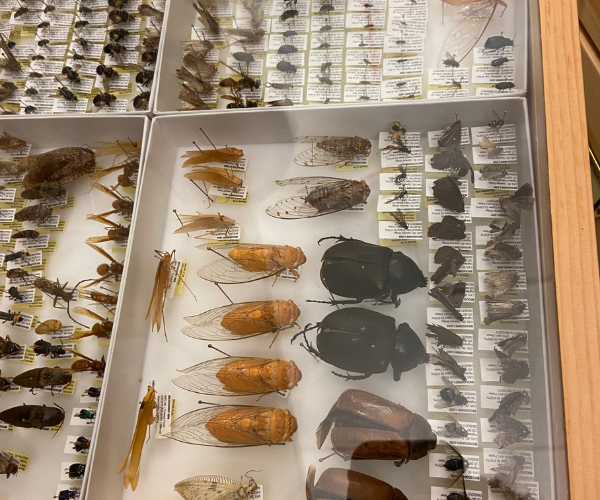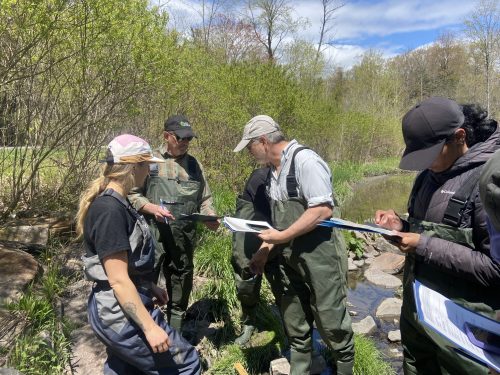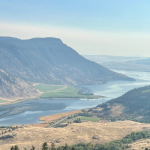Ontario groups learn about bugs as bioindicators
Written by Gwen Janz, Biomonitoring Technician, Living Lakes Canada.
My feet are kicking, sliding, and twisting. A cloud of sand and silt stirs up from the bottom of the stream. Zigzagging from one bank to the other, I slowly make my way upstream, gripping my net tightly as I go. I am trying to catch benthic macroinvertebrates, small bugs that live on the bottom of streams and rivers. These bugs are bioindicators that provide important information about the condition of the water.
During the first week of May, our biomonitoring team was in Ontario to train several community groups on collecting benthics for biomonitoring. This served a dual purpose: to help build capacity for long-term monitoring in local communities as well as collect samples for the STREAM (Sequencing the Rivers for Environmental Assessment and Monitoring) project.
STREAM is a community-based biomonitoring project that provides community groups with a powerful data tool for freshwater conservation. In comparison to traditional biomonitoring methods, STREAM offers faster turnaround times for more accurate species identification results. Sample processing at the Hajibabaei Lab comes at no cost to participating community groups.
Together with our STREAM partners from the Hajibabaei Lab at the University of Guelph, Living Lakes Canada’s biomonitoring team trained 29 individuals from six different Ontario-based groups using STREAM’s Field Manual. As the newest member of the biomonitoring team, it was my first time collecting benthics for community-based science.



DAY 1
We were given a tour of the Hajibabaei Lab in the Centre for Biodiversity Genomics, where all STREAM samples are sent and processed using DNA metabarcoding technology. Bulk DNA is extracted, and advanced bioinformatics are applied to track the benthic species collected by community groups. We then toured the Centre of Biodiversity Genomics’ Collections Unit, where microscopes, small vials, and countless insects lined the tables. Millions of samples are sent to the Collections Unit from around the world, reminding me of a vast bug library¹. It was fascinating to get a look behind the scenes of the happenings at the University of Guelph. I was amazed by the work of the Hajibabaei Lab team and how they meticulously analyze STREAM samples to generate data to better understand aquatic ecosystem health.
DAY 2
We headed to a section of Mill Creek, located close to Guelph, to train with Friends of Mill Creek. The creek has been altered and diverted to make way for human development, and Friends of Mill Creek are using STREAM to better understand the impacts of human development and other activities on the creek.
Although it was a cold and rainy day, our group eagerly stepped into the water for biomonitoring. Following STREAM field protocols, we practiced sample collection and processing. As I looked through my first sample, a crayfish greeted me with a shake of its claws.
DAY 3 & 4
Our team met with staff from Kawartha Land Trust and Kawartha Conservation, close to Peterborough. The enthusiasm of these groups was contagious. Eager to use STREAM to expand their existing biomonitoring programs, they were thrilled to learn about the benefits of using DNA metabarcoding technology.
DAY 5
The final training day was spent with EcoSpark and Swim Drink Fish Canada in Toronto. These groups are interested in using STREAM both for environmental monitoring as well as for their environmental education programs with students from schools across Toronto.
When I looked into my net that day, five fish were trapped inside. We quickly released them and watched as they returned to their hiding places, and we continued to practice sampling. Currently, STREAM methods and protocol rely on benthic macroinvertebrates, but staff at the Hajibabaei Lab are working on methods to capture the biodiversity of other taxa groups for future biomonitoring.
Looking back at our time in Ontario, I feel grateful to have had the chance to meet so many dedicated individuals working towards a shared goal: protecting water for future generations. I learned that the STREAM project engages community members in multiple beneficial ways: not only does it help to generate valuable freshwater data, it also increases public awareness of the health of local freshwater bodies.
Going forward, Living Lakes Canada plans to offer more STREAM trainings in Ontario. Long-term biomonitoring of rivers and streams across Canada is needed to assess how aquatic ecosystems are changing over time due to impacts of climate change, industry, and more. Projects like STREAM generate data on freshwater health, giving us information that can help to protect the water on which we all depend.





